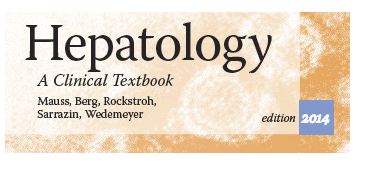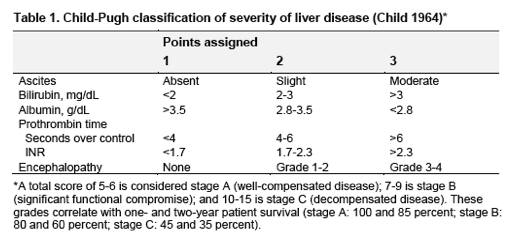| |
Hepatology - A Clinical Textbook edition 2014
- Mauss, Berg, Rockstroh, Sarrazin, Wedemeyer
|
| |
| |
Download the PDF here

Selected Excerpts
The goal of antiviral therapy is to cure hepatitis C via a sustained elimination of the virus. A sustained
elimination of HCV is achieved if the HCV RNA remains negative six months after
the end of treatment (sustained virological response, SVR) (Table 1). Follow-up
studies document that more than 99% of patients who achieve an SVR remain HCV
RNA negative 4-5 years after the end of treatment and no signs of hepatitis have
been documented (Manns 2008, Swain 2010). Importantly, long-term benefits of
SVR are the reduction of HCV-related hepatocellular carcinoma and overall
mortality (Backus 2011, Veldt 2007, van der Meer 2012). In 2011, the FDA
accepted SVR-12 (HCV RNA negativity 12 weeks after end of treatment) as
endpoint for future trials because HCV relapse usually occurs within the first 12
weeks after the end of treatment.
Today, assessment of liver fibrosis by noninvasive techniques such as transient elastography (FibroScan®)
or by the moretraditional liver biopsy is the best predictor of disease progression (Gebo 2002,
Caviglia 2014).

Around 30 to 40% of patients with chronic hepatitis C have an extrahepatic
manifestation of HCV (Zignego 2008). There is a wide variety of extrahepatic
manifestations described as being associated with HCV:
- Hematologic manifestations (essential mixed cryoglobulinemia, lymphoma)
- Autoimmune disorders (thyroiditis, presence of various autoantibodies)
- Renal disease (membranoproliferative glomerulonephritis)
- Dermatologic disease (porphyria cutanea tarda, lichen planus)
- Diabetes mellitus
Injection drug use has been the most commonly identified source of acute HCV
infection.....HCV infection also has been associated with a history of intranasal cocaine use,
presumably due to blood on shared straws or other sniffing paraphernalia. This may
explain partly the recent increase in cases of acute HCV infections in HIV+ MSM
(Schmidt 2011, Rockstroh 2012).......The risk of perinatal transmission of HCV in
HCV RNA-positive mothers is
estimated to be 5% or less (Ohto 1994). In mothers coinfected with HIV this risk. correlates
with immunosuppression and has been described in up to 20%.
Most patients with chronic infection are asymptomatic or have only mild
nonspecific symptoms as long as cirrhosis is not present (Merican 1993, Lauer
2001). The most frequent complaint is fatigue. Less common manifestations are
nausea, weakness, myalgia, arthralgia, and weight loss. HCV infection has also been
associated with cognitive impairment. All these symptoms are non-specific and do
not reflect disease activity or severity
It is estimated that there are 2 - 5 million HCV - positive persons in Europe. The
prevalence of HCV antibodies in otherwise healthy blood donors is approximately
1.6% in the United States, 1.15% in Italy, 0.4% in Germany, and 0.23% in
Scandinavia (RKI 2004, Hatzakis 2011).
According to the World Health Organization there are about 150 million people
chronically infected with the
hepatitis C virus (HCV), corresponding to 2-2.5% of the world's total population.
There are considerable regional differences. In some countries, eg, Egypt, the
prevalence is >10% (WHO 2013). In Africa and the western Pacific the prevalence
is significantly higher than in North America and Europe.
|
|
| |
| |
|
|
|